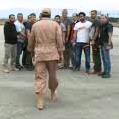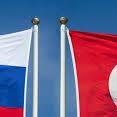(PONARS Eurasia Policy Memo) As events in recent years have made clear, Vladimir Putin’s Russia operates by a Cold War logic that divides the globe into spheres of influence: a “balanced system of interests and relations, defined in the world long ago.” For Russia, the conflict in Ukraine is a major battle in the struggle with the West over vital extraterritorial interests. And like in the Cold War, nuclear weapons capabilities retain a central place in the struggle.
Cold War Redux?
The Kremlin’s aim is to use its nuclear capacity as a means to emphatically draw a red line against Western expansion, particularly of the military sort. The implications of its posturing are clear: Moscow retains the right to employ the full spectrum of its capabilities to deter the West not only from acting within Russian territory but in its broader sphere of vital interests. Such an approach intends to put before Western states the stark choice of staying out of Russia’s affairs or risking wider war and even nuclear conflict.
This kind of posturing is reminiscent of the Cold War doctrine of limited retaliation. Russian officials have invoked their country’s nuclear capabilities on numerous occasions. An example is the warning Russia’s ambassador to Denmark made when he stated that in case Denmark were to join the European ballistic missile defense program it risked having its ships become Russian nuclear targets. We also note how Putin last year recalled Nikita Khrushchev, “who pounded his boot at the UN, and everyone in the world, primarily in the United States, NATO, thought….[the Soviets] might just hit us with all those missiles, it’s better to treat them with respect.” Putin appears to cast himself in the same light, employing nuclear brinksmanship in an effort to get the West to leave Russia alone (ironically, in the same speech, he blamed Khrushchev for illegally giving away Crimea).
“Extended” Deterrence
At first glance, Russia might appear to have a more routine nuclear strategy. The 2015 Russian military doctrine notes that Russia regards the application of nuclear weapons as a last resort against conventional aggression “when the existence of the state is under threat.” In a 2013 speech, Putin said, “The sovereignty, independence, and unity of Russia are undeniable. These are the ‘red lines’ no one is to cross.”
The problem is that Russia does not clearly outline the perimeter of its vital “state” interests. When it turns out that Russia reserves the right to use nuclear weapons to defend its annexation of Crimea, it raises the question of how far the Kremlin is willing to go. In the state-produced Russian television documentary, Crimea: Road to the Motherland, in response to a question about putting Russia’s nuclear weapons on high alert, Putin said, “We were ready to do this… [Crimea] is our historical territory. Russian people live there. They were in danger. We cannot abandon them.” But if Crimea is a part of the historical Russian “unity” that can be defended by invoking the nuclear threat, then all post-Soviet states are technically eligible to be likewise “defended.”
Ukraine itself certainly appears to fall into this category. Ukraine is important to Russia for a number of reasons but two dominate in particular. The first has to do with “civilizational” politics. Ukraine is Russia’s closest neighbor in terms of culture, society, and religion. A successful transition for Ukraine can indicate to Russians that they too can change their country’s governance. Second, with its “besieged fortress” complex, Russia cannot accept even the slightest possibility that NATO will encroach on its significant southwestern border, something the Kremlin believes is inevitable without resistance, considering Ukraine’s current pro-Western/Euroatlantic orientation.
Russian specialists appear to agree that the Kremlin views Ukraine in this light. Retired lieutenant-general Evgeny Buzhinsky argues that for Russia, Ukraine is a red line, especially a Ukraine that is hostile to Russia. Fyodor Lukyanov has similarly observed that Ukraine is “seen by many people as something that’s actually a part of our country, or if not part of our country then a country that’s absolutely essential to Russia’s security.” A principal point for many in the Russian elite is that the United States has been doing its best to alienate Ukraine from Russia, stoking conflict between the two fraternal nations.
The Ukraine conflict thus serves two Russian aims: to keep Ukraine in its sphere of influence and to persuade the West that in case of crossing this or other such “red lines,” armed conflict will ensue. Being much weaker than the West with regard to conventional forces, Russia puts great significance on asymmetric strategies. In this light, invocations of nuclear deterrence are cut from the same cloth as “hybrid warfare.”
What’s more, Russia’s military doctrine itself suggests that Russia perceives nuclear weapons not only as a last resort but as a potentially useful instrument of warfare. In other words, Russia retains the right to use nuclear weapons on a “tactical” level against adversaries as a way “to de-escalate” local conflict. In this context, Russia still views its nonstrategic nuclear weapons (totalling more than 2,000 warheads) as a compensatory measure for its conventional inferiority vis-à-vis the West. This forces Western states to weigh the potentially dire consequences of getting too involved militarily in conflicts in countries like Ukraine or Georgia.
The Kremlin has made other efforts to demonstrate the credibility of a war with the West. The number of Russian military exercises in border regions including Kaliningrad, Crimea, and the Arctic increased 3.5 times this year in comparison with 2014, and the number of people engaged in these exercises was twice more than originally planned. These exercises included equipment capable of deploying both conventional and nuclear arms.
The Kremlin also emphasizes the unpredictable roles of emotion and patriotism. It adopts the role of an actor that may end up unable to control its own actions, forcing the West to play the role of the responsible partner.
How Far Will Moscow Go?
There remains the critical question of whether Russia’s “sphere of interests” includes all post-Soviet states, even those that have become NATO members. This summer, Russian parliamentarians asked the Prosecutor General’s office to “check the legality” of the recognition of the independence of the Baltic states from the Soviet Union. To a certain extent, Putin aggravated this concern, saying: “If I wanted, Russian troops could not only be in Kyiv in two days, but in Riga, Vilnius, Tallinn, Warsaw or Bucharest too.”
Russian analyst Andrei Piontkovsky has even formulated the so-called “Narva paradox” as a potential trigger for World War III. In his opinion, Russia could seek to create a “Donetsk scenario” in a Baltic city like Narva, where a “struggle of Russians for their rights” would be supported by “little green men.” This situation would put NATO in a situation where it must decide either to risk nuclear conflict with Russia or demonstrate the non-credibility of NATO defense commitments, burying NATO as an alliance.
There is, however, another interpretation of Russian meddling in NATO states. Moscow does not aim to trigger the “Narva paradox” so much as to encourage the West to avoid it altogether. In other words, Russia intends for Western allies to back away from an unpalatable choice by standing down in Russia’s “sphere of interest,” thereby making the threat to themselves disappear. Putin seeks to establish and maintain clear lines between spheres of influence, not overstep them.
Conclusion
The Ukraine conflict is part of a broader strategy of signaling to the West that meddling in Russia’s sphere of interest can force the unpalatable choice between risking nuclear war or undermining the NATO alliance. Putin’s threats are a bid to follow Khrushchev’s recipe of restoring Russia’s sphere of influence. The risk is that Putin could one day lose his sense of limits and, like Khrushchev in 1962, imperil global stability.
Polina Sinovets is Associate Professor in the International Relations Department, Odessa Mechnikov National University (Ukraine).
[PDF]










